
Basque is the last surviving Paleo-European language spoken indigenously in Europe, predating the Indo-European languages of the Bronze Age invasion of Europe from the Black Sea by pastoralists whose descendant languages dominate the continent today. Basque is spoken by the Basques and other residents of the Basque Country, a region that straddles the westernmost Pyrenees in adjacent parts of northern Spain and southwestern France. Linguistically, Basque is classified as a language isolate, as a relationship to any of the other known extinct pre-Indo-European languages of Europe has not been established, nor is it related to the later arriving Indo-European languages. The Basques are indigenous to, and primarily inhabit, the Basque Country. The Basque language is spoken by 28.4% (751,500) of Basques in all territories. Of these, 93.2% (700,300) are in the Spanish area of the Basque Country and the remaining 6.8% (51,200) are in the French portion.
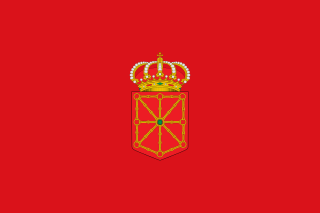
Navarre, officially the Chartered Community of Navarre, is a landlocked foral autonomous community and province in northern Spain, bordering the Basque Autonomous Community, La Rioja, and Aragon in Spain and Nouvelle-Aquitaine in France. The capital city is Pamplona. The present-day province makes up the majority of the territory of the medieval Kingdom of Navarre, a long-standing Pyrenean kingdom that occupied lands on both sides of the western Pyrenees, with its northernmost part, Lower Navarre, located in the southwest corner of France.
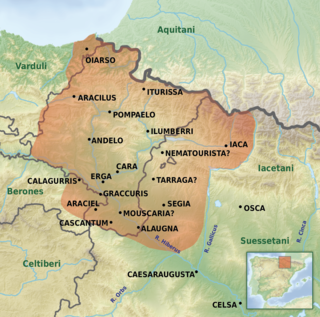
The Vascones were a pre-Roman tribe who, on the arrival of the Romans in the 1st century, inhabited a territory that spanned between the upper course of the Ebro river and the southern basin of the western Pyrenees, a region that coincides with present-day Navarre, western Aragon and northeastern La Rioja, in the Iberian Peninsula. The Vascones are often considered ancestors of the present-day Basques to whom they left their name.
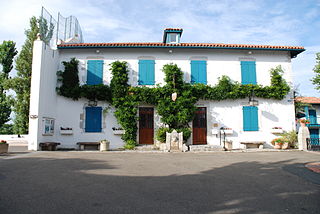
Arcangues is a commune in the Pyrénées-Atlantiques department in the Nouvelle-Aquitaine region of southwestern France in what was formerly the Basque province of Labourd.
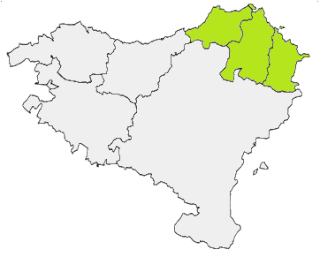
The French Basque Country, or Northern Basque Country, is a region lying on the west of the French department of the Pyrénées-Atlantiques. Since 1 January 2017, it constitutes the Basque Municipal Community presided over by Jean-René Etchegaray.
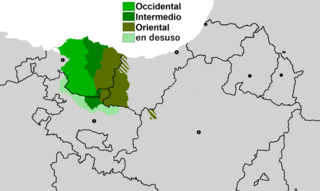
Biscayan, sometimes Bizkaian, is a dialect of the Basque language spoken mainly in Biscay, one of the provinces of the Basque Country of Spain.
Gipuzkoan is a dialect of the Basque language spoken mainly in the central and eastern parts of the province of Gipuzkoa in Basque Country and also in the northernmost part of Navarre. It is a central dialect of Basque according to the traditional dialectal classification of the language based on research carried out by Lucien Bonaparte in the 19th century. He included varieties spoken in the Sakana and Burunda valleys also in the Gipuzkoan dialect, however this approach has been disputed by modern Basque linguists.
Upper Navarrese is a dialect of the Basque language spoken in the Navarre community of Spain, as established by linguist Louis Lucien Bonaparte in his famous 1869 map. He actually distinguished two dialects: Meridional and Septentrional. However, the southern varieties became extinct early in the 20th century mainly after becoming absorbed by Northern Spanish or Aragonese. So documentation of the Meridional subgroup is rendered impossible. It is unknown whether the extinction was due to Francisco Franco's fierce suppression of Basque culture.

Navarro-Labourdin or Navarro-Lapurdian is a Basque dialect spoken in the Lower Navarre and Labourd (Lapurdi) former provinces of the French Basque Country. It consists of two dialects in older classifications, Lower Navarrese and Labourdin. It differs somewhat from Upper Navarrese spoken in the Peninsular Basque Country.

Standard Basque is a standardised version of the Basque language, developed by the Basque Language Academy in the late 1960s, which nowadays is the most widely and commonly spoken Basque-language version throughout the Basque Country. Heavily based on the literary tradition of the central areas, it is the version of the language that is commonly used in education at all levels, from elementary school to university, on television and radio, and in the vast majority of all written production in Basque.

Aezkoa Valley is an administrative unit of Navarre, Spain. It is formed by several smaller municipalities: Abaurregaina, Abaurrepea, Aria, Aribe, Garraioa, Garralda, Hiriberri (town), Orbaitzeta and Orbara.

Basque dialects are linguistic varieties of the Basque language which differ in pronunciation, vocabulary and grammar from each other and from Standard Basque. Between six and nine Basque dialects have been historically distinguished:

The Vasconic languages are a putative family of languages that includes Basque and the extinct Aquitanian language. The extinct Iberian language is sometimes tentatively included.
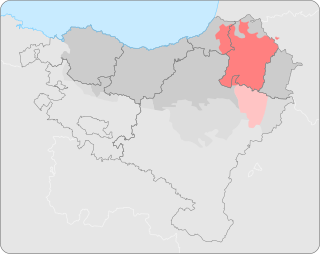
Salazarese is the Basque dialect of the Salazar Valley of Navarre, Spain.
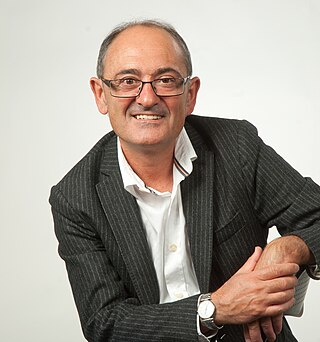
Koldo Zuazo is a Basque linguist, professor at the University of the Basque Country and specialist in Basque language dialectology and sociolinguistics.
José Ignacio Hualde is a Spanish linguist specialised in Basque linguistics and in Spanish synchronic and diachronic phonology, professor of linguistics in the Department of Spanish and Portuguese, and in the Department of Linguistics, at the University of Illinois at Urbana–Champaign. He is also the current vice president of the Association for Laboratory Phonology.
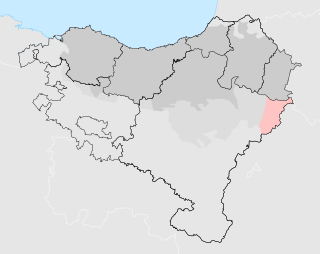
Roncalese is an extinct Basque dialect once spoken in the Roncal Valley in Navarre, Spain. It is a subdialect of Eastern Navarrese in the classification of Koldo Zuazo. It had been classified as a subdialect of Souletin in the 19th-century classification of Louis Lucien Bonaparte, and as a separate dialect in the early-20th-century classification of Resurrección María de Azkue. The last speaker of the Roncalese, Fidela Bernat, died in 1991.

Alavese is an extinct dialect of the Basque language spoken formerly in Álava, one of the provinces of the Basque Country of Spain. The modern-day communities of Aramaio and Legutio along the northern border with Biscay do not speak the Alavese dialect but a variant of the Biscayan dialect instead and while overall some 25% of people in Álava today are Basque speakers, the majority of these are speakers of Standard Basque who acquired Basque via the education system or moved there from other parts of the Basque Country.
Koldo is a male given name. Notable people with this name include:
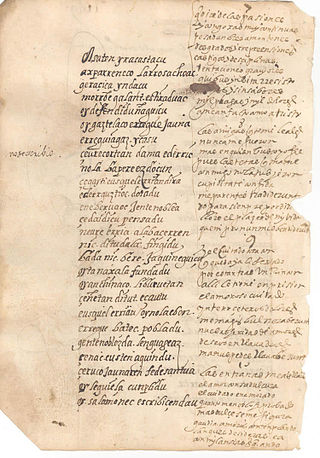
16th-century Basque literature begins with three authors considered classics: Joan Perez de Lazarraga, Bernard Etxepare and Joanes Leizarraga. In the manuscript of the first of them, discovered in 2004, the influence of the traditional court lyric, the Italian novela pastoril and the popular Basque templates can be observed. In the case of Etxepare, often compared to the Archpriest of Hita, the influence of French literature has been mentioned. Regarding Leizarraga, translator into Basque of the New Testament and other works on religious themes, he stands out for his attempt to find a unified language—a concern of many of the later authors—and for his use of cultured verbal forms and compound sentences, nonexistent in written literature up to that time.















